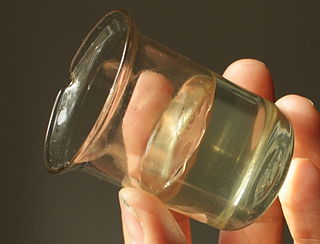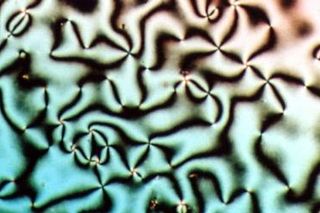
In condensed matter physics and materials science, an amorphous or non-crystalline solid is a solid that lacks the long-range order that is characteristic of a crystal. In some older books, the term has been used synonymously with glass. Nowadays, "glassy solid" or "amorphous solid" is considered to be the overarching concept, and glass the more special case: Glass is an amorphous solid that exhibits a glass transition. Polymers are often amorphous. Other types of amorphous solids include gels, thin films, and nanostructured materials such as glass.

In physics, a state of matter is one of the distinct forms in which matter can exist. Four states of matter are observable in everyday life: solid, liquid, gas, and plasma. Many intermediate states are known to exist, such as liquid crystal, and some states only exist under extreme conditions, such as Bose–Einstein condensates, neutron-degenerate matter, and quark–gluon plasma, which only occur, respectively, in situations of extreme cold, extreme density, and extremely high energy. For a complete list of all exotic states of matter, see the list of states of matter.
A biaxial nematic is a spatially homogeneous liquid crystal with three distinct optical axes. This is to be contrasted to a simple nematic, which has a single preferred axis, around which the system is rotationally symmetric. The symmetry group of a biaxial nematic is i.e. that of a rectangular right parallelepiped, having 3 orthogonal axes and three orthogonal mirror planes. In a frame co-aligned with optical axes the second rank order parameter tensor of a biaxial nematic has the form
Olaf Karthaus is a German polymer chemist and Professor at the Chitose Institute of Science and Technology in Chitose, Hokkaidō, Japan, researching polymer chemistry, thin films, photonics, and nanotechnology.

In chemistry, the organic compound triphenylene is a flat polycyclic aromatic hydrocarbon (PAH) consisting of four fused benzene rings. Triphenylene can be isolated from coal tar. It is also made synthetically by synthesis and trimerization of benzyne. One molecule of triphenylene has delocalized 18-π-electron systems based on a planar structure. It has the molecular formula C
18H
12.
In liquid crystals, homeotropic alignment is one of the ways of alignment of liquid crystalline molecules. Homeotropic alignment is the state in which a rod-like liquid crystalline molecule aligns perpendicularly to the substrate. In the polydomain state, the parts also are called homeotropic domains. In contrast, the state in which the molecule aligns to a substance in parallel is called homogeneous alignment.
Surface freezing is the appearance of long-range crystalline order in a near-surface layer of a liquid. The surface freezing effect is opposite to a far more common surface melting, or premelting. Surface Freezing was experimentally discovered in melts of alkanes and related chain molecules in the early 1990s independently by two groups. John Earnshaw and his group used light scattering, which did not allow a determination of the frozen layer's thickness, and whether or not it is laterally ordered. A group led by Ben Ocko, Eric Sirota (Exxon) and Moshe Deutsch discovered independently the same effect, using x-ray surface diffraction which allowed them to show that the frozen layer is a crystalline monolayer, with molecules oriented roughly along the surface normal, and ordered in an hexagonal lattice. A related effect, the existence of a smectic phase at the surface of a nematic liquid bulk was observed in liquid crystals by Jens Als-Nielsen and Peter Pershan in the early 1980s. However, the surface layer there was neither ordered, nor confined to a single layer. Surface freezing has since been found in a wide range of chain molecules and at various interfaces: liquid-air, liquid-solid and liquid-liquid.
Liquid-crystal polymers (LCPs) are a class of aromatic polymers. They are extremely unreactive and inert, and highly resistant to fire.

Martin Schadt is a Swiss physicist and inventor.

A liquid crystalline mesophase is called lyotropic if formed by dissolving an amphiphilic mesogen in a suitable solvent, under appropriate conditions of concentration, temperature and pressure. A mixture of soap and water is an everyday example of a lyotropic liquid crystal.
A blue phase mode LCD is a liquid crystal display (LCD) technology that uses highly twisted cholesteric phases in a blue phase. It was first proposed in 2007 to obtain a better display of moving images with, for example, frame rates of 100–120 Hz to improve the temporal response of LCDs. This operational mode for LCDs also does not require anisotropic alignment layers and thus theoretically simplifies the LCD manufacturing process.
The glass–liquid transition, or glass transition, is the gradual and reversible transition in amorphous materials, from a hard and relatively brittle "glassy" state into a viscous or rubbery state as the temperature is increased. An amorphous solid that exhibits a glass transition is called a glass. The reverse transition, achieved by supercooling a viscous liquid into the glass state, is called vitrification.
Discotic liquid crystals are mesophases formed from disc-shaped molecules known as "discotic mesogens". These phases are often also referred to as columnar phases. Discotic mesogens are typically composed of an aromatic core surrounded by flexible alkyl chains. The aromatic cores allow charge transfer in the stacking direction through the π conjugate systems. The charge transfer allows the discotic liquid crystals to be electrically semiconductive along the stacking direction. Applications have been focusing on using these systems in photovoltaic devices, organic light emitting diodes (OLED), and molecular wires. Discotics have also been suggested for use in compensation films, for LCD displays.

Hexa-peri-hexabenzocoronene is a polycyclic aromatic hydrocarbon with the molecular formula C42H18. It consists of a central coronene molecule, with an additional benzene ring fused between each adjacent pair of rings around the periphery. It is sometimes simply called hexabenzocoronene, however, there are other chemicals that share this less-specific name, such as hexa-cata-hexabenzocoronene.
Liquid crystalline elastomers (LCEs) are slightly crosslinked liquid crystalline polymer networks. These materials combine the entropy elasticity of an elastomer with the self-organization of the liquid crystalline phase. In liquid crystalline elastomers, the mesogens can either be part of the polymer chain or they are attached via an alkyl spacer.
Nelamangala Vedavyasachar Madhusudana is an Indian physicist and an emeritus scientist at Raman Research Institute. Known for his research on liquid crystals, Madhusudhana is an elected fellow of Indian Academy of Sciences and Indian National Science Academy. The Council of Scientific and Industrial Research, the apex agency of the Government of India for scientific research, awarded him the Shanti Swarup Bhatnagar Prize for Science and Technology, one of the highest Indian science awards, for his contributions to physical sciences in 1989.











